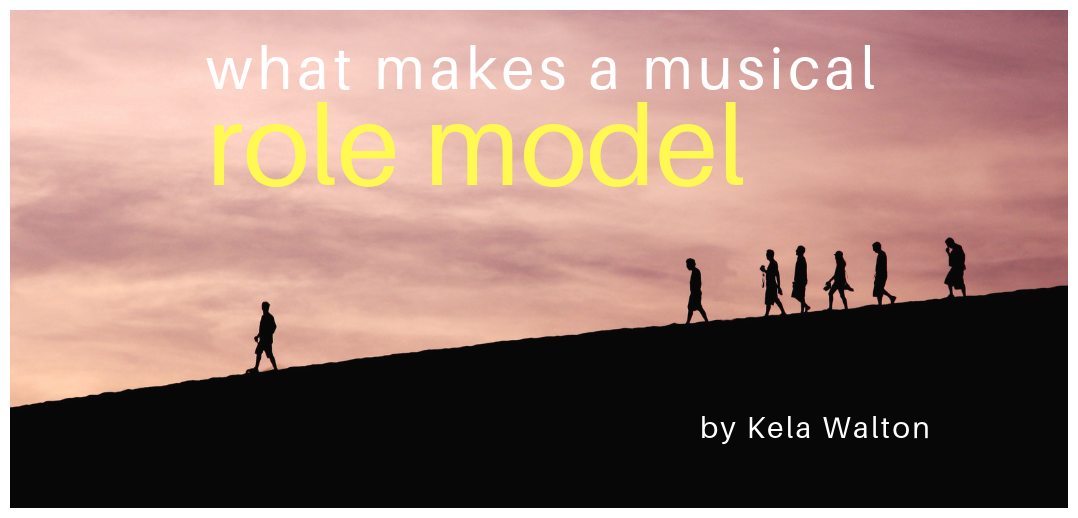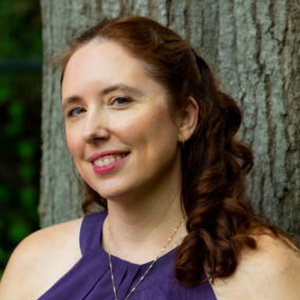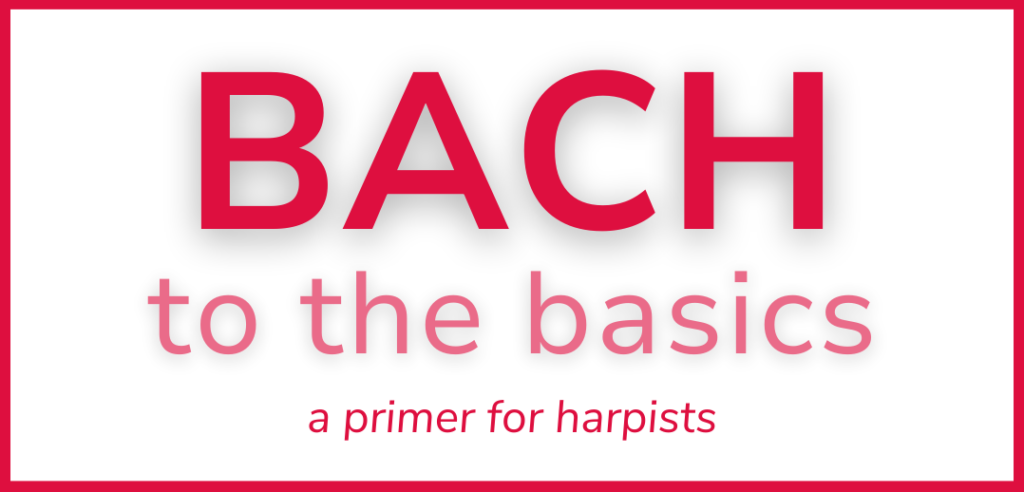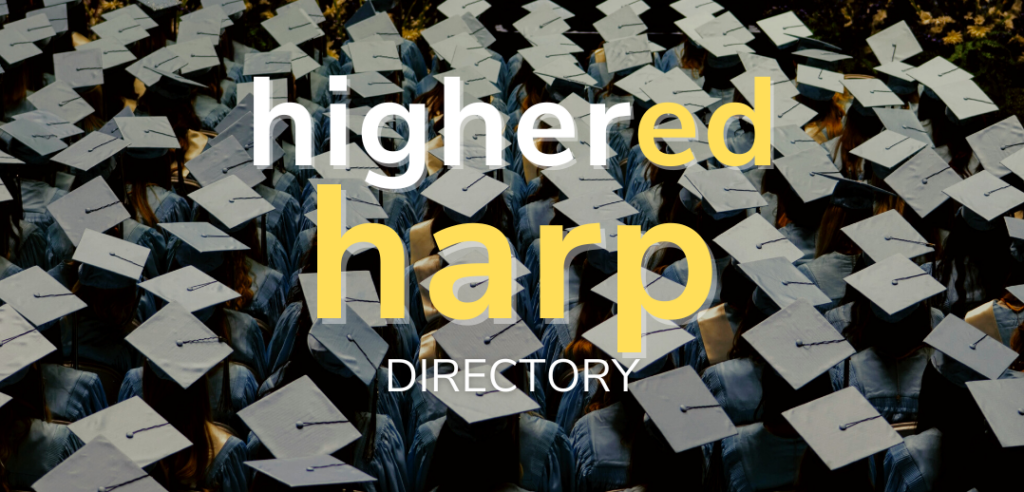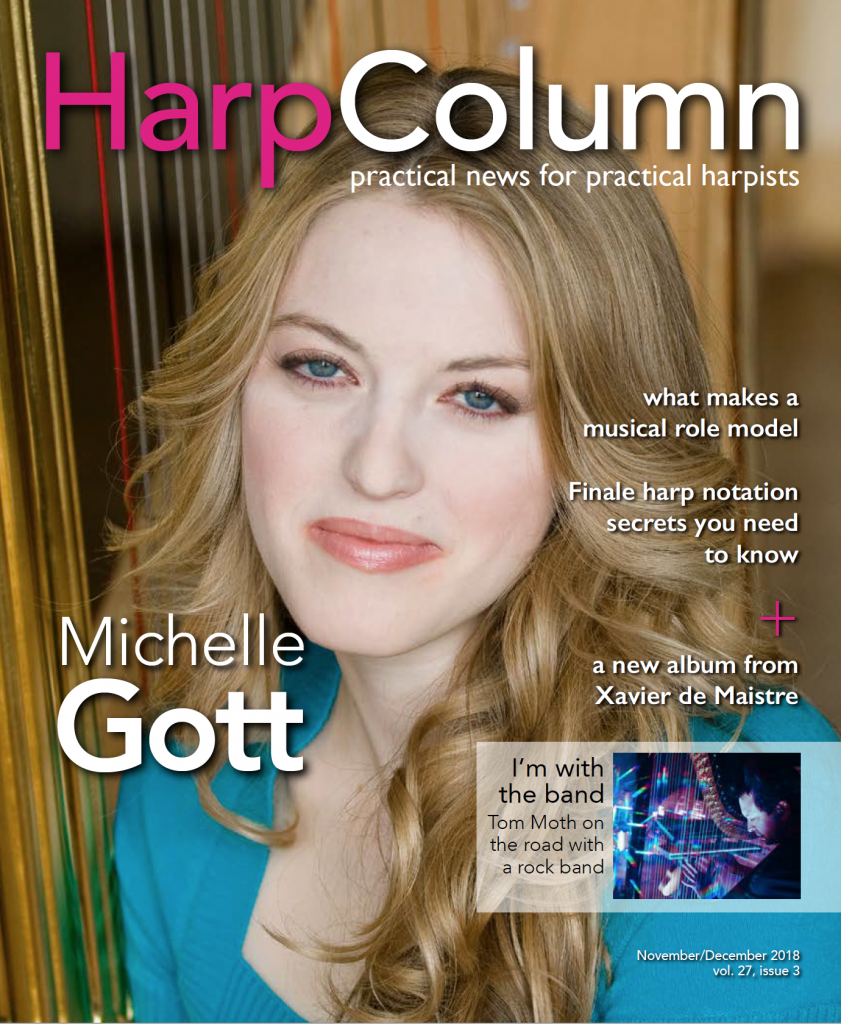Do you remember thinking, “I want to be just like this person when I grow up”? There are people in our lives that inspire us, change us, and make us better simply by knowing them. As musicians we seek guidance to hone our skills. As people we want to know what is possible. We all look to our role models to show us the way.
But what makes someone’s musical life worth modeling? I recently came across this intriguing explanation of what a role model is, and what makes it different than others we look up to.
“An idol may have a desirable, glamorous life that we eye appreciatively but never actually emulate. A hero may blaze the way forward, teaching and encouraging. But a role model is a person who offers, often unwittingly, an accessible pattern of living,” writes Faith Durand, editor-in-chief at The Kitchn food blog.
With that definition in mind, who is your musical role model? What qualities do they inspire you to emulate in your daily life? Harp Column asked harpists of all ages and career paths to tell us about their musical role models, and the impact these important people have on their lives today.
Collegiate connection
As you might expect, many harpists name their college teacher—the one who sends them out into the professional world—as their role model.

“For the past 35 years, I have aspired to be more like my former harp teacher, Mary Brigid Roman,” says New York City harpist Laura Sherman. “Though I only studied with her for two years, her influence as a teacher, performer, and person has guided me daily. Personally, she is one of the most authentic people I have ever known. She is genuinely kind, deeply thoughtful, and incredibly organized. Professionally, her flawless technique, impeccable preparation, and deep artistry always left me spell-bound. And she is certainly the most generous teacher I have ever known.”
Even after leaving Florida State University, Sherman says she would call her former teacher in a panic about learning an important orchestral harp part for the first time. “She would send me her meticulously-marked part, a cassette recording of the piece (dating myself here), and sometimes, copies of the relevant pages from the score. Recently I counted all of the harp parts that she sent me over the years: there were 50 of the most important pieces in the orchestral repertoire.”
Sherman says Roman helped her figure out how to be in the world in every sense of the word. “Not only did Mrs. Roman teach me how to play the harp, how to prepare all types of music, and how to rewrite unplayable orchestra parts,” Sherman explains, “she also shared with me, mostly by example, how to be a strong and gentle woman, an honest and caring person, and the importance of good nutrition, exercise, and loving relationships. To this day, I pattern my days around these key concepts that I learned from her: practice, eat right, exercise, treat people kindly, be generous, and love abundantly.”
Selfless devotion
Juilliard grad Bridget Kibbey points to her college teacher Nancy Allen as her most important musical role model. “Alongside a tireless commitment to excellence in her own playing, she is devoted to her students in a selfless way: from making sure graduates have playing opportunities, to a sensitive-yet-honest approach to teaching. I’m forever inspired by her playing, yet advocacy for harpists.”
Nicole Brady, a college professor herself at Brigham Young University, says she is inspired by the lessons she learned from her professor in Moscow at Gnessin Russian Academy of Music, Milda Agazarian. “I owe so much to her tutelage and her belief in me.” Brady says she seeks to emulate Agazarian’s pedagogical style with her students at BYU. “The pure amount of time she spent with me—up to nine hours of lesson time a week—allowed her to give me a wide range of concepts while also making sure I could understand and apply them. She was demanding, but I never left feeling I couldn’t do something. She made sure I could do it before I walked out the door.” She explains, “[Agazarian] celebrated my successes, even the smallest ones when I mastered a slightly different hand position or scale. She never looked down on my dreams or aspirations and instead pushed me harder toward them.” Kindness and diligence are also important qualities Agazarian exemplified in lessons. “She never hesitated to tell me or another student when we needed to improve something, but she always did it with kindness and with a solid belief in our ability to accomplish what she was asking. She seemed to recognize that I would do whatever it took, and I would practice with great diligence and discipline. She met me there with the same effort, giving me that diligence, focus, and discipline from the teaching end.”
With her own studio of students, Brady says she tries hard to be all in. “I feel that was what Milda gave me, and I want the same thing for my students and even my own children.” Brady acknowledges that giving the amount of time to her students that Agazarian gave her isn’t realistic in the American educational system. “However, I really want to give my students that same attention and focus when I am working with them. I also want my students to know how much I believe in them. I try to pass on the same idea that if a student is willing to work hard, I will meet them with everything I can to help them.”

Grace Browning does not name a harpist, but rather her first youth orchestra conductor, Luis Haza, as one of the most influential role models in her early musical life. “[Haza] taught me the power of persistence, passion, and perspective.” At age 12 Haza fled to the U.S. from Cuba with his mother after his father was killed by Castro’s regime. Despite the upheaval in his youth, Haza went on to attend Curtis and later win a first violin position with the National Symphony Orchestra. Browning describes conducting youth orchestra as Haza’s real passion. “He loves guiding aspiring musicians through great orchestral masterpieces for the first time, experiencing the excitement and joy of musical discovery through their eyes, and committing himself to the musical and personal growth of each student.”
Browning says four years under Haza’s direction in the American Youth Philharmonic Orchestra transformed her from a lackadaisical, insecure, and directionless teenager to an impassioned, self-assured, and hungry young harpist. “[Haza] instilled in me a life-long passion for ensemble-playing, the perspective that every day is a gift, and the lesson that hard work always pays off,” Browning notes.” His child-like curiosity, endless enthusiasm, and commitment to each student’s individual artistry are the qualities I strive for in my own teaching.”
Early Lessons
A harpist’s relationship with their first teacher is a special one, many times becoming the most influential connection in a their musical life, with the impact felt long after their lesson days are over.
Rebecca Todaro beautifully illustrates why so many of us view our teacher as our role model as she describes the impact of her first teacher and role model Elizabeth “Bette” Roth. “Simply being a stable constant in my weekly life allowed me to absorb musical expectations and habits to establish an accessible pattern of living.” Todaro adds that she continues to follow that model today. “[Her] generosity and kindness cemented many musical habits in my psyche that I lean on daily.” Like many young harp students, Todaro describes herself as extremely driven and motivated to learn, yet with no concept of what was expected at lessons or even how to practice. Todaro admits that most of Roth’s teaching fell on deaf ears at the time. ”It took years for her tutelage to sink in, on many points.” But she adds, “I am still reaping the benefits of the technical foundation she gave all of her students, the love of orchestral playing and chamber music, and the routine of monthly studio classes for her students.”
As Todaro grew from a student to a professional, she says she continued to be influenced by Roth. “The balance of work and family that I witnessed truly helped as my own life grew after graduate school to have a husband and two children of my own.” But Todaro speaks candidly about the struggle to find time for everything in our lives. “In all truthfulness the ‘balance’ I speak of has always led to a deficit of time behind the harp, in my adult life, with much more time spent in the family arena.” Thankfully she has more wisdom from Roth to share, “All the hours of practice you put in become a saving account. Interest accrues, and when needed, that nest egg of dedication will be there.” What a comforting and fitting analogy.
Many teachers do much more than teach rolled chords and harmonics. They go above and beyond, showing their students how to navigate life beyond the harp bench. Todaro describes herself as a troubled teen and was a frequent guest in her teacher’s home during the years she studied with Roth, eating dinner with the family and tagging along to orchestra concerts. “Gentle nudging from her regarding social cues, long term plans, and priorities very much kept me headed down the right path.”
Robbin Gordon-Cartier’s first teacher Leone Paulson also went to great lengths for her students. “Each summer she took 10-15 students away to study and practice the harp for all of July and August. From the age of 9 to 20, I celebrated my July birthday with my teacher and harp friends—two years in Johnson, Vermont and eight years in Dublin, Ireland.”
Gordon-Cartier laments that teachers who start students often are forgotten once the students move on to the teachers who prepare the older students for careers, competitions, and fame. Many of [Paulson’s] students are now professional harpists, and that is an important testimony to her. Gordon-Cartier adds, “Leone Paulson showed us the love of the harp and should never be forgotten.”
Many of us can relate to the experience of hearing our teacher’s words come out of our mouth, but a role model’s influence goes beyond words. Gordon-Cartier tells us about the moment she realized how much Paulson’s influence extends into her daily life. “I teach in a public school with classes of eight and more students each day. One day I looked around my room, reflected on trips that I take my students on, and realized that I had become my teacher. She helped us in day-to-day life issues, and those lessons are what kept me always playing the harp—despite the various twists and turns my life took.”
Gordon-Cartier adds, “My teacher never preached at us, but she always reminded us that there was more to life than winning a competition or playing a perfect concert. She taught us to understand that if you worked hard, honestly, and consistently, you would always present your best self. And at least for God, that was good enough!”

Julia Kay Jamieson credits much of her approach to music to the lessons she absorbed from her first harp teacher Jocelyn Chang. “Jocelyn approached every aspect of music with curiosity and creativity—teaching, practice, improvising, working with composers, interacting with brides—nothing was a formula with her.” Jamieson says Chang’s teaching was filled with plenty of experience and knowledge, and she had hundreds of tricks up her sleeve. “Each person and each situation was given unique thought, consideration, and empathy. [She was] tireless when it came to the pursuit of deeply understanding music and people. This approach to music fosters a kind of playfulness and flexibility as well.” Jamieson muses, “I think of her often as I teach and play.”
Stephanie Claussen, too, points to her first teacher, Cathy Victorsen, as her most influential role model. “I studied with her from the time I was 7 years old until I graduated from high school. I don’t remember thinking of her as a role model at the time. Yet when I think back to what propelled me forward the most in my musical life, I picture myself sitting in harp lessons, listening in total excitement, while she played the finished version of the piece I was about to start learning. It was the best part of every lesson.”

For Claussen, the fact that Victorsen offered an accessible model of what could be achieved was crucial. She says, “Listening to Cathy playing a piece that I too would be able to play in a month or so was far more motivational to me as a young harpist than hearing any number of harp masters or visiting artists performing musical wonders. I was always very focused on the immediate goal set before me: I wanted to play that specific piece just like she did.”
Claussen admits it was only later in life that she became conscious of her role model’s influence on her. “As I grew older, I started to appreciate her emphasis on musicality and melody. I distinctly remember her waltzing around her living room to demonstrate the ‘feel’ of a piece in 3/4 time. I’m now the one waltzing for my students.”
Balancing work life and
personal life
The challenge of balancing professional and personal demands, can be tricky for many of us. This important skill is difficult to teach, and perhaps better learned by observing our role models as Ruth Acuff discovered.
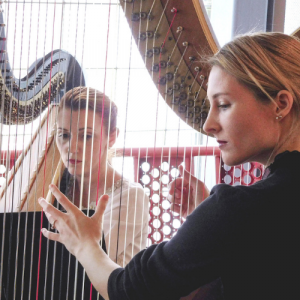
Ruth Acuff credits her role model and harp teacher Maria Duhova Trevor as the source of inspiration for how to be a well-rounded, full-time musician and how to balance all the parts of being a professional with daily life. Like many busy professionals Acuff admits, “Balance between practice, performance, business, and personal life can be a challenge. Sometimes one thing can take over everything. [My teacher was] a lifesaving example of balance, showing me that each aspect of life plays a role in the others. I remember one instance when she told me she was staying home to practice that evening instead of going out for dinner with friends. I felt inspired by her dedication and professionalism. While in another instance, she told me enough practice for now, it’s important to relax sometimes.”
Musical and spiritual role models
For some, music can be an expression of faith. For legendary harpist and teacher Susann McDonald, her musical role model was also a spiritual role model.
McDonald reminisces, “My beloved teacher Henriette Renié was such a great role model to me, both musically and spiritually.” McDonald traveled to France at 17 to study with Renié, and recalls, “She greeted me in her foyer and embraced and asked me, ‘Do you love the harp?’ I stammered in my limited French, ‘Oui, beaucoup!’”
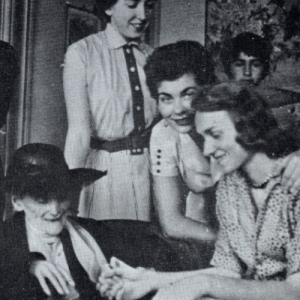
McDonald continues, “I adored my lessons with her that summer, first in Paris, then at her summer villa in Etretat, on the Normandy coast. I finished high school and knew I wanted to return and study again with her. So I had two wonderful years under her tutelage. She often shared her deep faith with me. She rose early and went to early mass at a small Catholic Church around the corner. She then sat at her desk and wrote a daily devotion in little notebooks, then she would practice an hour. One day she said, ‘I am a Catholic and you are a Presbyterian, and I believe the Lord knows His own!’”
Upon hearing of Renié’s death shortly after returning to the U.S., McDonald remembers being inconsolable, as she had hoped to return for more lessons. “I wept for days,” McDonald recalls. A friend offered solace in the form of a poem by Mary Lee Hall which ends, “…complete these dear unfinished tasks of mine, and I, perchance, may therein comfort you!” Eventually McDonald went on to teach Renié’s method and to perform and teach most of her major compositions and transcriptions. “I also wrote short devotions based on my Bible reading each day, as I was influenced by her example.” Years later McDonald published a book with many of these short devotions, Praise the Lord with the Harp.
The idol becomes the role model
Like many harpists, Alfredo Rolando Ortiz was inspired as a beginning harp student by the recordings by iconic harpists.

Ortiz describes his early harp studies, “Just days after turning 15, I began to learn on a borrowed ‘arpa criolla’ a Venezuelan harp from the plains, also called ‘arpa llanera.’” Ortiz says he took what he calls second-hand lessons from a school friend, Fernando Guerrero Briceño, who was 13. “We had very few recordings at the time—only LPs—and all were of harp music. If I was to choose a role model, I would have to say that it was Paraguayan harpist Luis Bordón, whose LP Arpa Paraguaya en Hi Fi mesmerized me with his beautiful and impeccable technique and, most of all, his musical expression.”
It would be 15 more years before Ortiz would meet Luis Bordón, in 1976. “By then I had established my own personal style, but his music was the greatest influence in my early years. We became friends and shared many beautiful times through the years, until I had the privilege to play by his bedside during the last week of his life, in 2006, accompanied at times by his son on the guitar. Luis passed away as we were flying back home to California. There were many others that influenced my musical life, but Luis Bordón will always have a very special place in my heart and in my music.”
As a fledgling harp student, Juan Riveros was inspired by the recordings of Yolanda Kondonassis. “When I first heard her recording of Scintillation on her Salzedo’s Harp CD, I instantly felt incredibly moved not only by the beauty of the music, but also her ability to translate so many emotions into music. I look up to Ms. Kondonassis for her spectacular cleanliness, inspirational musicality, and genuine love for the harp.”
Now a student of Kondonassis at the Cleveland Institute of Music, Riveros writes, “I’ve learned to practice and train as an athlete, how to tackle challenges at the instrument, to stretch and warm up before every practice session, and to be aware of other influencing factors like diet, daily routine, etc.” Riveros says he strives to emulate Kondonassis’ dedication to a solid technical foundation. “The importance of consistent warm up routines have also transferred into my own playing, to ensure a technical foundation that can be applied to any context in playing the harp.”
Dual roles

Ann Hobson Pilot has certainly blazed trails in her career, making her a hero in the harp community, but she is also a role model to Mason Morton and Angelica Hairston.
Ann Hobson Pilot joined the Boston Symphony Orchestra in 1969 and was principal harpist from 1980 until her retirement in 2009. Mason Morton exclaims, “Do you hear those dates? That’s 40 years! She is my role model because almost nothing can fuel a person for 40 years besides passion for the harp, music, and self-confidence.”
“Mrs. Pilot began her career in the 1960s when our country was not as open to African-Americans performing classical music or for better terms, when the U.S. was segregated,” explains Morton. “This means that while Pilot was a citizen of this country, a graduate of the Cleveland Institute of Music, and after studying with the world-renowned harpist Alice Chalifoux for summers in Camden, Maine at the Salzedo Colony; it still was not enough. To some people, all they saw was an African-American woman playing the harp. Because of this, she was not able to stay or eat with her own colleagues when the orchestra toured in some venues. Could you imagine performing where some people do not want you there, just because of the color of your skin?”
Thankfully for the harp community, Pilot persisted. “She never cried victim,” Morton points out. “Instead, she worked. Because of Ann Hobson Pilot’s perseverance, all of us can hear her harp in Schindler’s List, countless recordings, and a harp concerto Pilot commissioned entitled, On Willows and Birches composed by John Williams. Furthermore, she is still performing and teaching today. Mrs. Pilot is my role model for harp excellence and unshakable character.”
Morton adds, “While studying with Mrs. Pilot, she taught me to put down excuses that were taught to me such as: I’m a slow learner or I don’t come from a musical family so a career in music will be near to impossible for me. She told me over and over, ‘There is no such thing as can’t.’ Through my listening to her wisdom, I have enjoyed musical success. I am very grateful that I met, studied with, and will always be a student of Ann Hobson Pilot.”
Angelica Hairston agrees with Morton, “Ann Hobson Pilot has consistently been my musical role model. As the first African American female to hold a principal position in a major symphony, she was the first harpist I’d ever studied with who not only performed in one of the top orchestras but who also looked like me.” Hairston elaborates, “As a young musician of color navigating the complexities of the classical music field, Ann Hobson Pilot provided a sense of community, a shared understanding, and a place to ask tough questions.”
Hairston says she learned high-quality artistry, professionalism, direct honesty, and kindness from Pilot, and she works to emulate those qualities every day. “I’m thankful for the doors that she opened for me, and I strive to continue her incredible legacy in my classroom each day.”
Hairston posits that Ann Hobson Pilot’s influence helped her become the person she is today. “She taught me that it was okay to be myself. She also taught me to use my platform to show others that they can be themselves in the classical field too.”
Our role model peers
You don’t have to be a famous harpist or an esteemed pedagogue to be a role model. Many of us find inspiration in the form of friends and colleagues.

Carter Williams was a 7-year-old beginning harp student when she first learned about her role model Madeline Olson. “We had the same harp teacher in Fresno—Laura Porter. At the time Madeline was Ms. Porter’s best student, and she was doing amazing things.” Williams explains, “Ms. Porter would always talk to me about her and share the exciting things Madeline was doing. I think she was trying to motivate me, and if she was, it worked.”
Williams’ teacher told her about Olson playing on the radio for KVPR’s Young Artists Spotlight and shared the repertoire Olson was playing, “as a way to motivate me to practice so I could learn the songs Madeline played. Since I can remember, I have always looked up to her and admired her harp playing skills.” Williams was in a lesson with Porter when Olson called to share that she had been accepted at Juilliard. Williams remembers feeling so excited for her. “Since that day it has been my goal to go there too.”
On a trip to New York last year, Williams met her role model. “I must say I was starstruck. After years of hearing about Madeline Olson and watching videos of her, I finally got the privilege of meeting her, and it was better than I had hoped. We went and had a snack, and I was able to talk to her and ask her questions that I had always wanted to ask.”
Like all good role models, Olson is a daily source of inspiration Williams. “I have had my own solo benefit concerts to raise money for different things. I have also played on the radio and at different events. I like to play in competitions and learn lots of different pieces.” This summer Williams attended the Young Artists Harp Seminar (YAHS) for the first time. “Madeline went to YAHS when she was my age, so I was really excited to go too.” Carter sums up her role model this way, “I can’t say enough about Madeline and how much she has inspired me as a harpist every day.”
Perhaps you’ve had more than one role model throughout the various stages of your musical life. Your role model might be a beloved teacher, trusted friend, or even (gasp) a non-harpist. Because of their influence, we find the path toward self improvement, fulfilling work, and happy lives is a bit easier to navigate. We must also take care to remember we may be a role model for others. Thanks to our role models, we know how to strive to be deserving of the label. •
Article Extra
Modeling Mom and Dad

For many people—musicians and civilians alike—our first role models are our parents. Stephanie Claussen and Julia Kay Jamieson point to their parents as being important role models in both their musical and personal lives.
Growing up in a house where her mother gave piano lessons, Jamieson says, “I heard daily examples of genuine kindness, patience, and caring for her students. She was 100% present with each student.” Looking back, Jamieson has given a lot of thought to how much her mother, “enjoyed teaching, and how much time she spent outside of lessons reading books on pedagogy and pursuing ways to improve as a teacher, even after years of experience as a piano teacher as well as an elementary school teacher. She delighted in both teaching and learning in a way that was contagious.”
Jamieson draws upon both her mother’s and her teacher’s methods in her own teaching. “I try to encourage creativity and playfulness in other harpists with my workshops and compositions. When I prepare a recital, curiosity is a great motivator at the beginning, middle, and end of the process.” With her own students, Jamieson realizes, “The more I am open to understanding them, seeing their inspirations, and enjoying their unique path, the better at teaching I become.”
Claussen also looked to the example of her parents when she was deciding whether or not to pursue harp performance as a career. “I found that my parents who were both self-employed, one as a graphic designer and one as an artist, were my role models. I had grown up with the idea that it was normal to work from home, and so I knew it was possible. Now I find myself thinking back to their example when it comes to scheduling, work/leisure balance, meal planning, etc.






